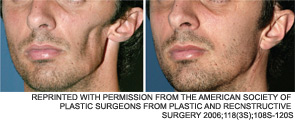Dr. Netterville is the senior author of a poster study of the procedure presented by one of his residents, Sanjay M. Athavale, MD, at the 2011 Triological Society annual meeting in Chicago (A182. Free dermal fat graft reconstruction of the head and neck: a cosmetically appealing reconstructive option). The study showed a very low incidence of side effects: Only three of 62 patients in the study (4.8 percent) experienced a complication related to their FDFG recipient sites, Dr. Athavale reported. Moreover, none of the patients had abdominal donor site complications.
Explore This Issue
September 2011As for postoperative cosmetic results, those were assessed with “a novel patient-based numeric grading scale,” Dr. Athavale said. The grading scale yielded very high numerical levels of patient satisfaction (an average 4.9 out of 5), leading the authors to conclude that the technique “can be used in a variety of locations and patients tend to be very happy with their final cosmetic outcome.”
Dr. Netterville told ENT Today that although he was impressed with the results detailed in the poster, those numbers tell only part of the story. He stressed the “hugely important” economic benefit to using FDFGs, rather than other, more extensive surgeries, such as free flap transfers. With the latter approach, he said, hours of microsurgery are required to attach the free flaps to the vasculature of the donor site, resulting in hundreds of thousands of dollars in health care costs. “With our approach, we’re not using a flap at all; we simply excise a volume of fat with a layer of its overlying dermis attached. It’s a much simpler procedure, and it only incurs about a $1,500 cost to the health care system.”
Dr. Netterville added that he does not use electrocautery to harvest the free fat graft “so that we don’t damage any of the fat cells. I can’t prove it, but I feel strongly that is a key to our success with the procedure. Lots of other surgeons use electrocautery, and I really think it contributes to poorer outcomes.”
Fat Grafts and War Injuries
Still, there are surgeons who push the envelope when it comes to using fat grafts without any dermis or other structures attached to repair major facial deformities. Two noted proponents of fat grafting, Sydney R. Coleman, MD, a plastic surgeon in New York City, and J. Peter Rubin, MD, chief of plastic and reconstructive surgery at the University of Pittsburgh Medical Center (UPMC), have been using the grafts in soldiers with extensive soft tissue injuries incurred during the war in Iraq. The surgeons rely on fat harvesting, processing and injecting techniques that have been developed and continually refined over the past decade by Dr. Coleman (Clin Plast Surg. 2006;33(4):567-577), who visits UPMC regularly to assist in the procedures.

Leave a Reply